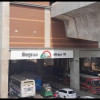Govt to address noise issue
The authorities of the Dhaka metro rail project have decided to take some extra measures to check noise, shock and vibration in key places like the Jatiya Sangshad Bhaban, Dhaka University, and National Museum.
Besides, additional measures would also be taken within the DU area to ensure that important establishments, including Raju Sculpture, TSC, mazars of three leaders, and the educational atmosphere are not affected.
“We will use technologies like Mass Spring System [MSS] in around 6km key places through the metro rail route to check sound, shock and vibration,” Mofazzel Hossain, project director of Dhaka Mass Rapid Transit Development (DMRTD) Project, told reporters at his office in the capital.
Side walls on both sides of the tracks would be made with concrete instead of glass to dampen noise, he said. The height of the side walls would be 4-4.25feet.
According to a study, the noise level in most places of the 20km Mass Rapid Transit (MRT) Line-6 route from Uttara to Motijheel is higher than normal. The movement of the metro rail will not add further noise, he claimed.
The existing noise level in DU library area is 67.5 decibels, 70 at TSC, and 68.2 at Doel Chattar, the PD said, adding that the noise from the movement of Metro rail would be maximum 61.9, 61.1, and 56.5 decibels in the areas respectively.
The distance between pillars in DU area would be 150 feet while the distance in other places would be 100 feet, he said. These steps would be taken keeping in mind that the aesthetic beauty is not affected and cultural activities within the campus are not hampered, he added.
Mofazzel said the height of the metro rail track would be 31 feet from the ground. It would be at least 45 feet at Farmgate and Sonargaon Hotel intersections, as two ramps of the proposed Dhaka Elevated Expressway would be there, he claimed.
Two-storey stations would be built along the route except for two three-storey stations in the two points due to additional height, he added.
The metro rail will have stations at 16 points in the city -- including at Uttara, Pallabi, Mirpur, Kazipara, Shewrapara, Agargaon, Bijoy Sarani, Farmgate, Karwan Bazar, Shahbagh, TSC, Press Club, and Motijheel.
He said they hope they can start the construction work of the metro rail depot in March and the main construction work of the route in November-December and operation of the dream project partially by the end of 2019.
A 10km stretch between Uttara and Agargaon, part of the 20km line that will go as far as Motijheel, would be launched initially.
The Tk 21,985 crore (approximately $2.5 billion) ambitious project is aimed at easing traffic congestion in the capital city through an improved, faster, comfortable and time-bound public transportation service.
According to the project director, a train with six air-conditioned spacious cars will operate every four minutes, enabling a commuter to travel from Uttara to Motijheel in just 38 minutes, which now takes around two hours on a week day.
A total of 24 such trains would carry 60,000 passengers every hour to both directions and drastically cut the number of private cars on the streets, Mofazzel said, adding that only 3.5 percent works of the project have been completed so far.
Replying to a query about a section of DU students' demand to change the metro rail route, Mofazzel said it was finalised in consultation with the DU authorities in 2011 and that there was no scope for changing the route now.
The PD said DU students' concerns about the environment, noise and vibration had been included in the tender documents and detail design and those would be strictly followed while implementing the project.
The metro rail cars would be air-conditioned and sealed. So the DU students' concern about people throwing things out the windows was irrational, he added.

 For all latest news, follow The Daily Star's Google News channel.
For all latest news, follow The Daily Star's Google News channel. 








Comments